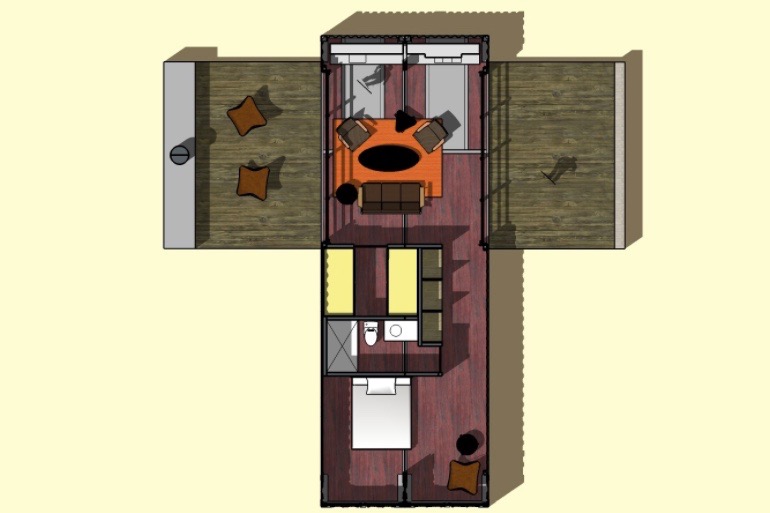Two dramatically different economic trends in America are converging in unexpected ways. On the one hand, environmental and zoning restrictions—enacted by states and municipalities—have helped drive up the cost of housing, spurring an affordability crisis in some communities. On the other, a shift in consumption patterns (even before the coronavirus) has caused the closure of many retailers and malls. Now, inspired builders and planners are looking to use these empty spaces to create housing in mixed-use developments, ranging from the outlying suburbs to central cities. Dozens of communities are reusing such spaces, and early successes have created momentum.
The rise of Amazon and other online merchants has undermined the profitability of many retailers and the malls that housed them, bringing widespread failures. Of the approximately 1,500 malls built in America since the mid-1950s, about 500 have either closed or turned their uses to something other than retail; hundreds more are projected to close in the next decade. Already, nearly 60 of these former malls have been reconstructed as new types of communities, featuring multifamily housing and other uses—typically some retail and office space. Another 75 projects of this type are in the planning stages.
A prototype of this new type of development has taken shape in Lakewood, Colorado. The state’s fifth-largest city, with some 150,000 residents, Lakewood suffered from the failure in 2000 of a giant indoor mall in the heart of the city, which otherwise lacked a dynamic downtown. The city and its development partners replaced the mall with a 22-block, walkable downtown-style development dubbed Belmar, with nine acres of urban parks, nearly 300,000 square feet of office space, street-level stores, and apartments and condos that house some 2,000 residents. Another several thousand residents live within walking distance of the $850 million project; property values in the area have soared. The project has been so successful that it has created a new challenge: how to deal with rapid urban growth. Last year, residents voted to cap new residential construction.
Something similar is transpiring in Annapolis, where developers took a desolate, abandoned, 1960s-era mall called Parole Plaza and transformed it into a village-within-a-city, with several hundred apartments, stores, and office space, designed in an updated Federalist style that echoes the city’s historical architecture. The development, called the Annapolis Town Center, is one of Maryland’s designated transit-oriented projects, built around a station on the state’s commuter-rail system.
But it’s not just malls that have gone dark. Decades ago, department-store chains built huge stores in downtowns. Many have sat empty for decades, but a few are now finding new life as residential communities. Montclair, a suburb of Newark that boasts its own downtown shopping area, once featured a two-story Hahne’s department store, the town’s biggest retailer. But the chain’s owner, May Department Stores, closed all its Hahne’s stores in 1989. For years, the Montclair site sat virtually empty as property owners tried vainly to lease the space to other retailers. Even amid a local economic boom, spurred by migrants from New York City snapping up homes in the area, the empty store slowed redevelopment of downtown until the town took a different approach. It authorized development of a six-story residential project, with 101 apartments and 35,000 square feet of retailing space at street level. The residential units have sold out and the retail space is fully leased, so the town is moving to redevelop more housing on an adjacent parking lot that previously served the store.
Similarly, the Hahne’s store in downtown Newark, a four-story, 400,000-square-foot outlet that once served as the company’s headquarters, remained unoccupied for 26 years, an eyesore in the middle of a struggling downtown. Today, that building, too, is finding life as a mixed-use structure, with a $174 million facelift. The new project includes affordable-housing units, an arts incubator operated by Rutgers University, and stores—including Newark’s first Whole Foods.
Though the word “mall” is often associated with suburban one- or two-story retail outlets, the golden age of shopping in America also featured high-rise retail developments built in cities—sometimes called vertical malls. Never as successful as their suburban counterparts, even during flush times, abandoned vertical malls in downtown areas are a prime target for multiuse redevelopment. In Rochester, for example, the Midtown Mall—once anchored by faded stores like McCurdy’s—closed in 2008. Developers are now engaged in a $59 million project, part of a broader downtown redevelopment, to revamp the empty 400,000-square-foot former mall into ground-floor retail, office space, and apartments, including affordable-housing units.
Some of these efforts face considerable hurdles beyond economics. Most malls were built in areas specially designated for them and their retail uses. Few old malls can be repurposed without government rezoning the land. Builders are paralyzed by new environmental reviews that can take years. Projects advance most quickly when government itself takes the lead, doing the necessary work first and soliciting private-sector partners confident of gaining community support. Even then, malls differ crucially from housing—they typically have less plumbing and sewage capacity, for example. That’s why many of these projects involve tearing down an enclosed mall and building something different from scratch, with all the associated costs. In some cases, alternative uses—like logistics facilities that can process packages shipped by online retailers—make more sense.
Still, with malls closing so quickly—check the popular site deadmalls.com—the problem of what to do with these deserted eyesores has been worrying local officials and planners for years. Suddenly, the thought of making a home where you or your parents may have once done your back-to-school shopping doesn’t seem so far-fetched.



 The latest data from the Black Knight McDash Flash Forbearance Tracker shows that the number of mortgages in active forbearance fell for the third week in a row. Overall, the number of active forbearance plans is down 57,000 from last week and 158,000 from the peak the week of May 22.
The latest data from the Black Knight McDash Flash Forbearance Tracker shows that the number of mortgages in active forbearance fell for the third week in a row. Overall, the number of active forbearance plans is down 57,000 from last week and 158,000 from the peak the week of May 22.

